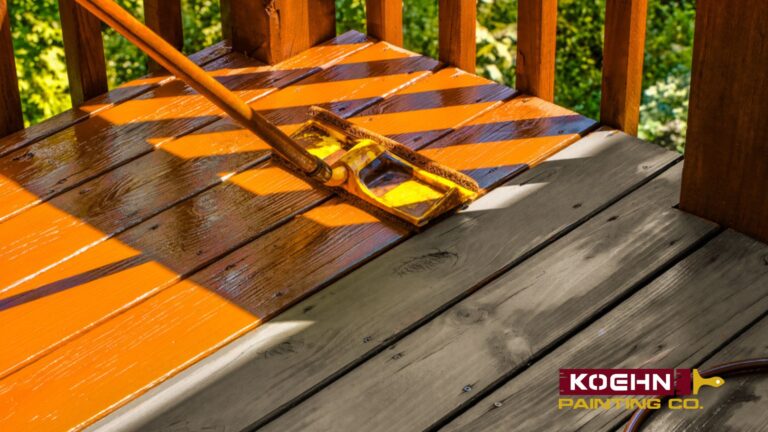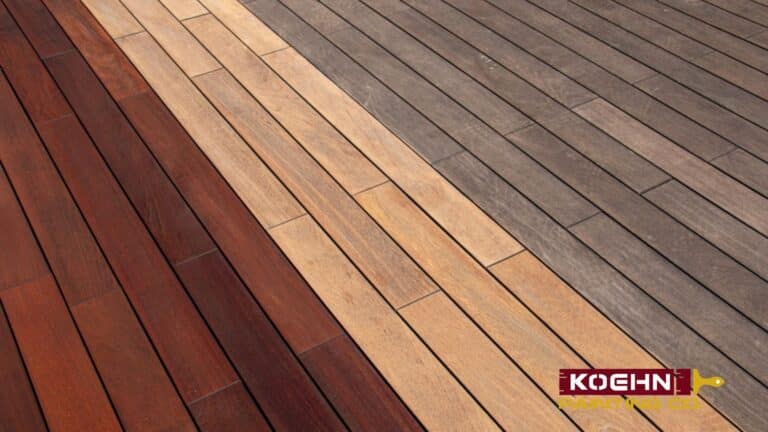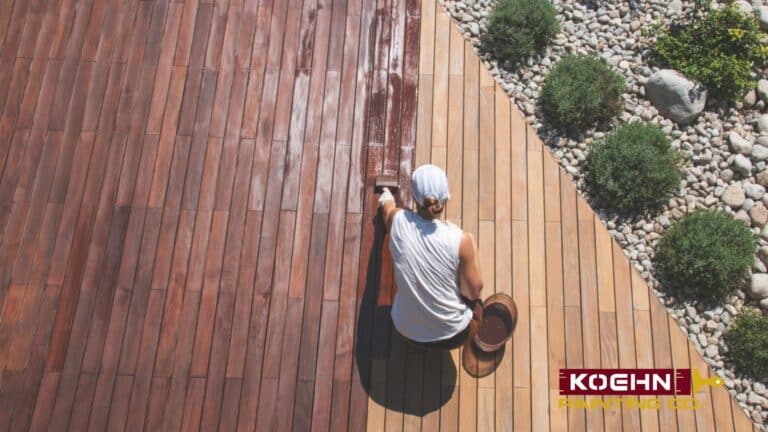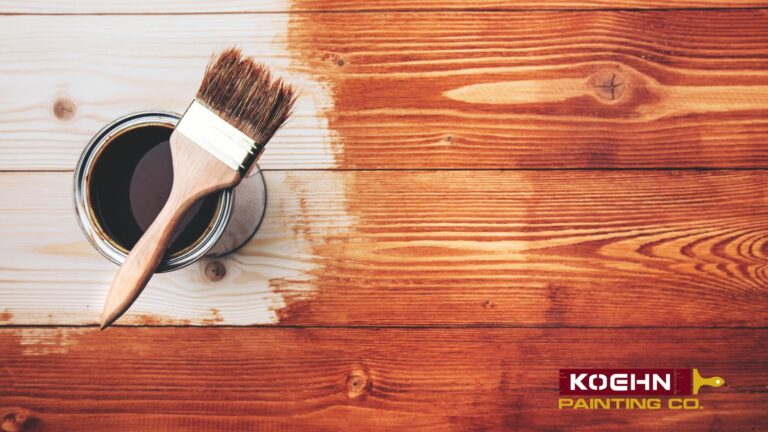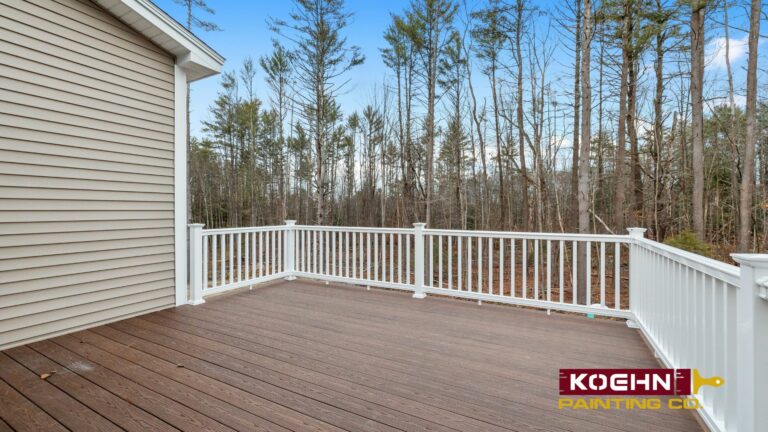Can You Stain a Painted Deck?
So, can you stain a painted deck? Staining a previously painted deck is possible, but it comes with serious caveats.
Paint creates a thick, non-breathable film that can crack or peel; stain is meant to soak into bare wood. For stain to adhere over paint, the existing coating must be sound, dull, and completely clean—otherwise, the new finish will peel quickly. A solid-color exterior deck stain is the safest choice if you leave the old paint in place. Because gel stains form a thick film, most manufacturers advise against using them on deck floors where standing water and foot traffic cause premature peeling.
Preparation is crucial. Start by identifying the type of paint, whether it is oil or latex, then scrape off any peeling sections and repair damaged boards. Clean the deck thoroughly, then lightly sand the intact paint with 120–150 grit to remove the sheen; drop to 80 grit only where you’re feathering the peeled edges.
Finer abrasives, like 320, might not be coarse enough to grip painted surfaces effectively. Test the stain on a small, hidden area before continuing. Skip varnish completely. Let the deck stain serve as the wear layer, and simply reapply the same solid deck stain every few years.
Common missteps—such as skipping sanding, staining over loose paint, selecting the wrong product, or neglecting a topcoat—lead to uneven color, premature peeling, and costly rework. Maintain the new finish by keeping the surface clean, limiting abrasive traffic, and recoating the sealer every couple of years.
DIYers with patience and attention to detail can achieve good results, but large or heavily weathered decks often benefit from professional refinishing. A pro crew can strip failing layers, diagnose hidden moisture problems, and apply compatible products for a longer‑lasting, even finish. Let’s dive deeper into this subject.
Can You Put Solid Stain Over Paint? The Basics of Both
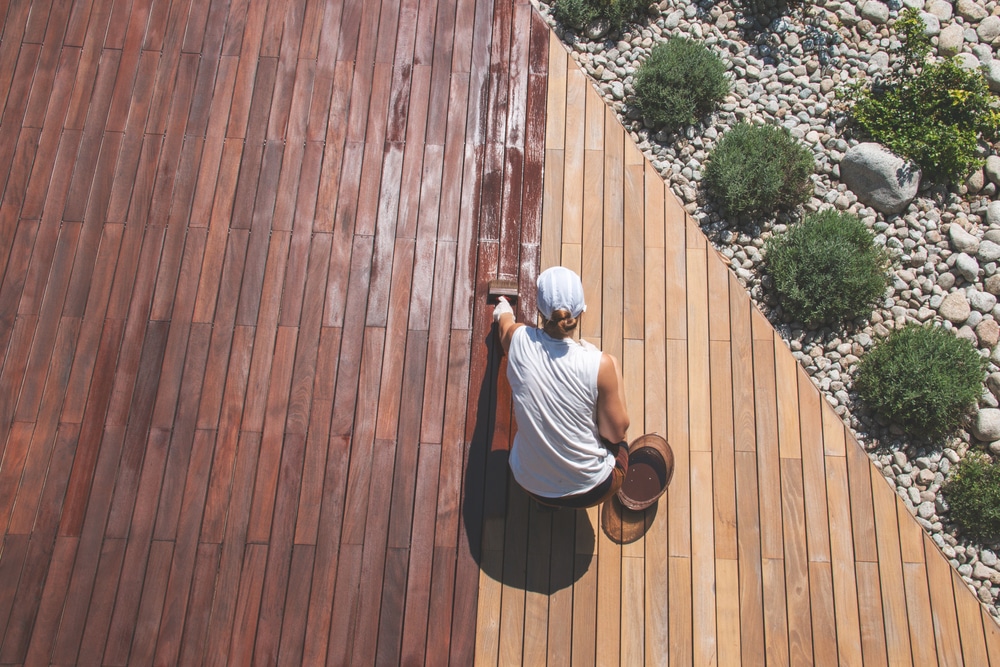
Let’s get this out of the way early: Can you put solid stain over paint? Technically, yes, but only under very specific conditions. And even then, it’s usually not the first recommendation from professionals unless you’re using a solid stain and you’ve done your prep work correctly.
Before we dig into that, let’s rewind and talk about what paint and stain actually do:
- Paint forms a thick film on top of the wood, sealing it off from the elements. It’s great at hiding imperfections and offers long-lasting protection when applied correctly. But that sealed layer can crack, peel, or bubble over time, especially if moisture gets trapped underneath. Paint doesn’t breathe well, and once it starts to fail, it tends to do so dramatically.
- Stain, on the other hand, is designed to penetrate the wood surface. Transparent and semi-transparent stains soak into the grain, enhancing the wood’s natural texture while offering some protection. Solid stains behave a bit more like paint—they sit closer to the surface and provide rich color coverage, but they still allow some of the wood texture to show through. Unlike paint, many stains are breathable, helping moisture escape and reducing the risk of peeling.
That’s where the challenge lies.
Stain needs to bond directly with the wood fibers. If the surface is already covered in paint, especially if it’s glossy or peeling, the stain has nothing to absorb into. It can end up sitting awkwardly on top, flaky, uneven, and short-lived. Even solid stain, which provides more coverage and thickness, won’t work well unless the paint underneath is sound, scuff-sanded, and thoroughly cleaned.
So, while the answer to “can you stain a painted deck” is technically yes, the real question is: Should you? That depends on your deck’s current condition and the results you want. If you’re aiming for a clean, even, long-lasting finish, staining directly over paint without proper prep is rarely worth the risk. Otherwise, it’s time to move from theory to real-world application. Before choosing stain or any other product, you should examine your deck’s surface. What type of paint is on it? Is it oil-based or latex? Is it peeling? What condition is the wood underneath in?
Contact us here if you would like to find the best painting contractor for your residential or commercial painting needs.
Before Applying Stain Over Paint, Check Your Surface
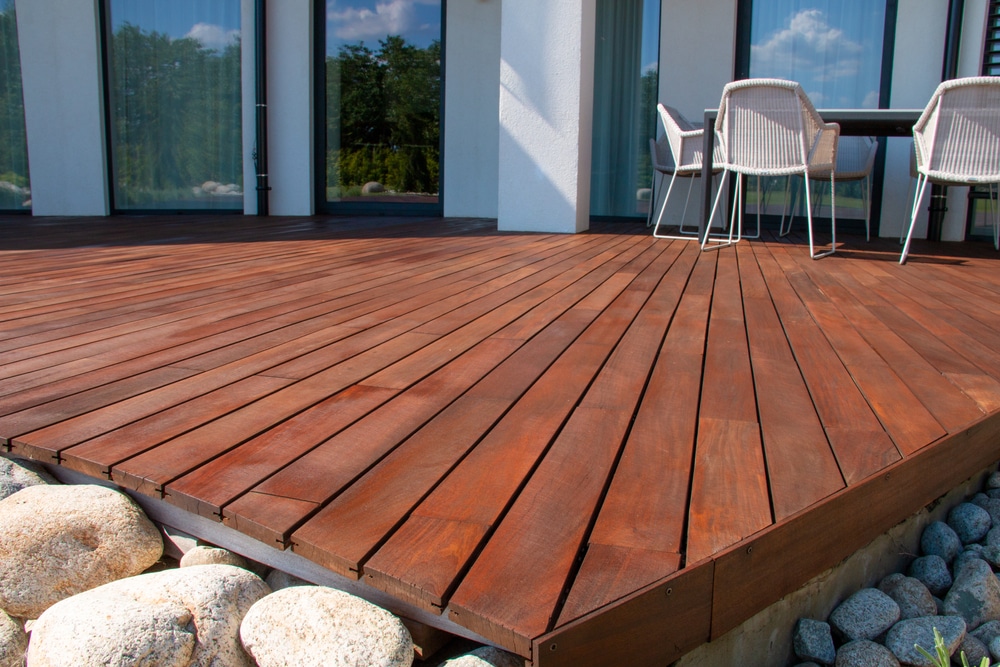
Before you consider picking up a can of stain, take a good, hard look at your deck. If you’re asking, “Can you stain a painted deck?”, the honest answer is that it depends on the surface you’re working with.
First, figure out what kind of paint is on your deck. Is it oil-based or water-based? You can do a quick test: rub a small area with a cloth dipped in rubbing alcohol. If the paint comes off, it’s latex (water-based). If not, it’s probably oil-based. Why is this important? Because stain won’t stick well to glossy, sealed, or flaking paint, especially if you don’t do serious prep.
Next, inspect for peeling, chipping, or bubbling. Any paint that’s coming loose has to go. Applying stain over paint that’s already failing is a shortcut to disappointment; it won’t bond, it won’t last, and it’ll likely peel within months.
Lastly, check the condition of the wood underneath. Is it soft or rotting in places? Is moisture trapped beneath the boards? If the wood has been sealed under paint for years, you may have hidden issues that could affect how well the stain absorbs, even if you strip the paint.
The Prep Work You Can’t Skip Before Staining
If you’re serious about achieving lasting results, here’s the truth: you can’t simply apply stain over paint and expect the best outcome. Even if you’re using a product designed for this purpose, proper preparation remains essential.
Here’s how to do it right:
- Clean and inspect the surface: Begin by thoroughly cleaning your deck. Dirt, oils, pollen, or mildew can prevent stain from bonding properly. Use a damp cloth or a deck cleaner, and allow everything to dry completely before proceeding. If you notice chipping or peeling paint, take a scraper and remove it—staining over paint only works if the underlying surface is stable.
- Lightly sand: Still wondering if you can stain a painted deck without sanding? Technically, yes, but it’s not recommended. Light sanding with 80-100 grit opens the paint surface enough for the stain to adhere properly. You don’t have to sand down to bare wood—just enough to dull the finish and smooth out imperfections. After sanding, use a vacuum, blower, or damp cloth to remove sanding dust—especially for outdoor surfaces, where tack cloths may not be effective due to debris volume and airflow. Pro tip: Don’t skip this step. Lack of adhesion is a common reason why stain over paint fails.
- Test your stain: Not all stains behave the same. Test a small area first to see how the color interacts with any leftover paint or exposed wood. This small check can save you a lot of frustration later.
- Seal the surface: After the final coat dries, usually in 24 hours, protect it with a weather-resistant sealer. Use a brush to apply thin layers, smoothing out any bubbles or streaks. This process helps preserve your finish and enhances durability, especially in high-traffic or outdoor areas. Let the solid-color deck stain be the wear layer; simply wash and re-coat every 2-4 years.
- Apply the finishing touches: Run your hand over the surface. If it’s not completely smooth, lightly sand again before applying another coat of sealer. Watch for drips, uneven patches, or bubbles, and make touch-ups as needed.
Common Pitfalls and Maintenance Tips
Common mistakes to avoid:
- Applying stain over peeling or glossy paint without prep
- Skipping the sanding step
- Using the wrong type of stain (avoid traditional stains unless the paint is fully removed)
- Not sealing after staining
- Rushing between coats
How to maintain your newly stained deck:
- Dust or rinse the surface regularly to prevent buildup
- Avoid dragging heavy furniture or sharp tools across it
- Keep it out of direct sunlight if possible to reduce UV wear
- Inspect the finish annually; high-traffic, full-sun decks may need a refresher coat every 2–3 years, while shaded areas often last twice as long
So, Can You Stain a Painted Deck?
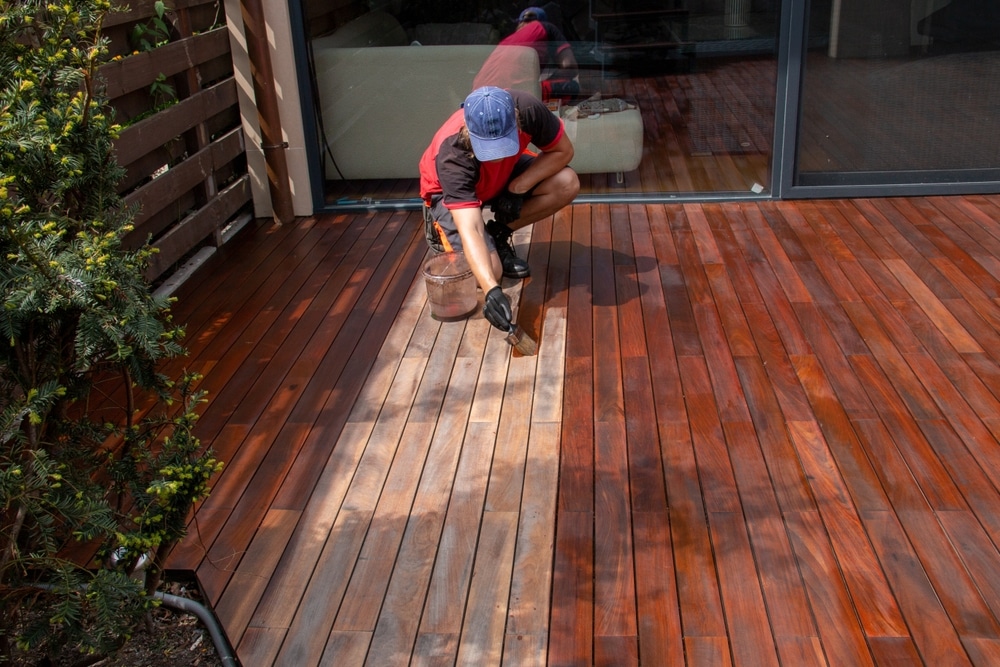
You landed here today wondering, “Can you stain a painted deck?” Yes, you can—but only if you use the right tools, do proper prep work, and set realistic expectations. We’ve covered everything from surface checks to selecting the right stain, and while it is possible to give a painted deck new life with gel or solid stain, the process isn’t easy. It demands time, care, and attention to detail, especially when stripping old paint, sanding, and sealing correctly.
When to Call in the Pros
If you’re a confident DIYer with free time, the steps are straightforward. However, for many homeowners, this job is more than a weekend project; it’s a multi-step restoration with real risks. Improper prep, incompatible products, or missed dry times can cause:,
- Peeling stain within months
- Uneven color and patchy finishes
- Poor adhesion that shortens the life of your deck
Hiring professionals ensures peace of mind. A skilled crew will evaluate your deck, select the appropriate materials, and deliver a clean, durable finish the first time. They’ll also help you avoid expensive rework and damage to your deck’s structure.
If your deck is large, heavily weathered, or has multiple layers of old paint, it may be worth calling in experts who know exactly how to bring it back to life, without the guesswork.
FAQs
What happens if you put deck stain over paint?
If you apply stain directly over paint—especially without proper prep—it won’t absorb into the wood and may not adhere well. Expect uneven color, poor coverage, and peeling within a short time.
Can you stain over paint on a deck without sanding?
You technically can, but it’s highly discouraged. Skipping sanding greatly reduces adhesion and increases the risk of peeling or blotchy coverage. Skipping sanding increases the risk of blotchiness, streaks, or total adhesion failure. Light sanding helps rough up the paint and gives the stain something to grip. It’s a quick step that dramatically improves the results.
